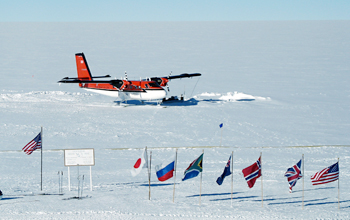News Release 13-010
Wreckage of Aircraft Located High in Antarctic Mountain Range
Joint U.S., New Zealand search-and-rescue effort pinpoints aircraft at 13,000 feet

A Twin Otter aircraft at NSF's Amundsen-Scott South Pole Station is shown in a 2006 photograph.
January 26, 2013
This material is available primarily for archival purposes. Telephone numbers or other contact information may be out of date; please see current contact information at media contacts.
The wreckage of a Twin Otter aircraft that was reported missing earlier this week in Antarctica has been found in a remote and mountainous area of the continent.
An initial assessment by Kenn Borek Air Ltd. of Calgary, Canada, the owner of the plane, deemed the crash "not survivable."
Weather has prevented search-and-rescue personnel from landing at the site.
The National Science Foundation (NSF), as manager of the U.S. Antarctic Program (USAP), has been cooperating with the Rescue Coordination Centre in Wellington, New Zealand, since the search-and-rescue effort to locate the missing aircraft--a de Havilland DHC-6 Twin Otter--began earlier this week.
Communication with the Twin Otter was lost on Wednesday night, New Zealand time, and search-and-rescue operations have been hampered by bad weather and poor visibility since that time.
The plane was flying in support of the Italian Antarctic Program under the logistical responsibility of the Italian National Agency for New Technologies, Energy and Sustainable Economic Development (ENEA). The aircraft was enroute from NSF's Amundsen-Scott South Pole Station to the Italian research station at Terra Nova Bay when contact was lost.
The three crew members were the only people aboard the plane at the time.
On the afternoon of Saturday, Jan. 26, local time, a ski-equipped LC-130 aircraft--operated by the New York Air National Guard for the USAP and flying from NSF's McMurdo Station--overflew the last known position from the aircraft emergency beacon and spotted the aircraft tail at an elevation of about 3,900 meters (13,000 feet) on Mt. Elizabeth, a 4,480-meter (14,500-foot) summit in the Queen Alexandra Range of the Transantarctic Mountains.
Subsequently, a Twin Otter carrying U.S. and New Zealand search-and-rescue personnel conducted an aerial survey of the site and determined that a landing by fixed-wing aircraft was not possible.
Later, two helicopters--one under New Zealand charter and the other flown for the USAP by PHI, Inc. of Lafayette, Louisiana--arrived at a small camp established roughly 50 kilometers (31 miles) from the crash location to support the operation.
The rescue teams will attempt to reach the site, if conditions permit, before returning to McMurdo Station.
-NSF-
Media Contacts
Peter West, NSF, (703) 292-7530, email: pwest@nsf.gov
Program Contacts
Brian W. Stone, NSF, (703) 292-8030, email: bstone@nsf.gov
The U.S. National Science Foundation propels the nation forward by advancing fundamental research in all fields of science and engineering. NSF supports research and people by providing facilities, instruments and funding to support their ingenuity and sustain the U.S. as a global leader in research and innovation. With a fiscal year 2023 budget of $9.5 billion, NSF funds reach all 50 states through grants to nearly 2,000 colleges, universities and institutions. Each year, NSF receives more than 40,000 competitive proposals and makes about 11,000 new awards. Those awards include support for cooperative research with industry, Arctic and Antarctic research and operations, and U.S. participation in international scientific efforts.
Connect with us online
NSF website: nsf.gov
NSF News: nsf.gov/news
For News Media: nsf.gov/news/newsroom
Statistics: nsf.gov/statistics/
Awards database: nsf.gov/awardsearch/
Follow us on social
Twitter: twitter.com/NSF
Facebook: facebook.com/US.NSF
Instagram: instagram.com/nsfgov


